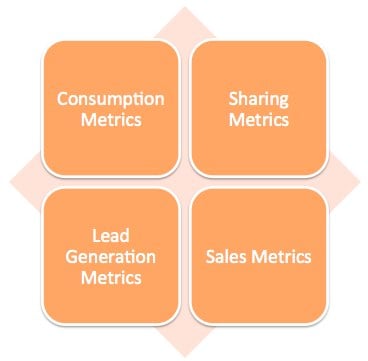In a post last week, I talked about turning your content marketing upside down and focusing first on what behaviors you want your content consumers to perform.
 Once you’ve done that and created content that you think will drive the desired actions, you can start measuring the efficacy of your content program. Content cannot be measured with a single metric, because no one data point can successfully or satisfactorily tell you whether your program is working. Instead, you need to create an array of metrics that are selected from four primary buckets:
Once you’ve done that and created content that you think will drive the desired actions, you can start measuring the efficacy of your content program. Content cannot be measured with a single metric, because no one data point can successfully or satisfactorily tell you whether your program is working. Instead, you need to create an array of metrics that are selected from four primary buckets:
1. Consumption Metrics
This is the most fundamental type of content metric, and is unfortunately also the place where many programs both start and end. It’s a critical data point, and is generally easy to derive through Google Analytics, YouTube insights, or similar. The key is to not stop your metrics train at this depot.
Key question answered: How many people consumed your content, measured as page views, downloads, or views?
2. Sharing Metrics
This is the metric type that probably gets too much love, because it’s often public which drives up the sexiness factor like cologne with bits of real panther. Here we’re measuring how successful your content is in getting consumers to share it with others, as determined by tweets, likes, Linkedin shares, Google + shares, Diggs, and the like.
Even though my blog includes public displays of affection like number of tweets (look at the top of this page), by far my favorite way to track sharing metrics is PostRank Analytics, which combines all the sharing behaviors into one jambalaya of data that’s easy to track and compare. Unfortunately, PostRank was bought by Google a few months ago, so you may not be able to sign up as a new user. My assumption, however, is that PostRank is being used as part of Google’s ranking algorithm for search and will eventually show up as a report in Google Analytics.
Key question answered: How often do consumers of your content share it with others?
(side note: you can impact this metric considerably by making social sharing easier and more obvious for your readers and watchers)
3. Lead Generation Metrics
Now we’re sniffing dollars, not just gathering eyeballs. Whether you require registration before allowing people to read/watch/download your content (which I usually don’t recommend), or whether you’re measuring leads generated after content is consumed, this is where we start determining whether the content marketing effort is making financial sense.
If you have an online lead form on your site, you can measure this by determining how many people went to the lead form immediately after consuming your content. You can also set a browser cookie and track when someone fills out that lead form after viewing your content, even if there is a 30 or 60-day interval between those events. If your leads are handled via phone, you can install a simple script that shows a different (trackable) phone number when people have first watched a video, downloaded a presentation, etc.
Key question answered: How often do content consumers turn into leads?
4. Sales Metrics
Holy grail time. If you’re using some sort of customer and prospect database (and you absolutely should be, even if it’s something simple like Highrise or Sugar CRM) you’ll want to note in the prospect record that the potential customer consumed content pieces X, Y, and Z. Then, when your crack sales team turns that prospect into a sale, determine the projected revenue and profit (lifetime value if you can) of that customer, and assign it to the content pieces.
Do not double up, however. You want to amortize your content value. If the customer consumed 3 pieces of content before buying and is worth $90,000 to your company, assign $30,000 to each content piece. Your major CRM and sales automation systems like Salesforce, Eloqua, Adobe Marketo Engage and similar make this process automated and easy.
Key question answered: How often do content consumers turn into customers?
If you know the answers to all four of those key questions, you have a holistic content marketing measurement system that will help you efficiently and effectively judge content pieces and archetypes. You can also determine actual ROI on a per piece basis, as well as on your overall initiative. (for more on calculating ROI, see this post on how to calculate blogging ROI in 9 steps).
Content isn’t just about consumption, so don’t only track consumption. It’s also about sharing and leads and sales.

